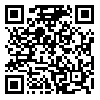دوره 2، شماره 1 - ( 11-1398 )
جلد 2 شماره 1 صفحات 19-7 |
برگشت به فهرست نسخه ها
گروه مدیریت ، دانشگاه فردوسی مشهد ، مشهد ، ایران
چکیده: (2333 مشاهده)
هدف این تحقیق تجزیه و تحلیل مزایای فناوری اطلاعات در سازمان ها است. بدین منظور ، 357 مشتری خدمات بانکداری الکترونیکی در این مطالعه شرکت کردند. آنها به پرسشنامه های سهولت استفاده ، مفید بودن ، کیفیت خدمات سیستم ، نگرش به فناوری ، تجربه خدمات و قصد استفاده از خدمات فناوری پاسخ دادند. برای تجزیه و تحلیل داده ها از مدل سازی معادلات ساختاری با نرم افزار SMARTPLS استفاده شده است. نتایج نشان می دهد که تأثیر پیشرفت فناوری بر تجربه خدمات و همچنین نگرش به فناوری با قصد استفاده از خدمات فناوری، رابطه ی معنی دار و مثبت دارند.
نوع مطالعه: پژوهشي |
موضوع مقاله:
سیستم های اطلاعاتی
دریافت: 1398/7/26 | پذیرش: 1398/10/4 | انتشار: 1398/11/11
دریافت: 1398/7/26 | پذیرش: 1398/10/4 | انتشار: 1398/11/11
فهرست منابع
1. Abdekhoda, Muhammad Hiva, Ahmadi, Maryam, Hossein, Aghafatemeh, Parikhani, Ismail, & Akram Farhadi (2013). Effective factors in information technology acceptance by staffs at the department of medical records based on Technology Acceptance Model in hospitals affiliated to Tehran University of Medical Sciences. Journal of Faculty of Paramedical in University of Medical Sciences, Tehran, 7, 4, 287298.
2. Ahn, T., Ryu, S., & Han, I. (2007). The impact of Web quality and playfulness on user acceptance of online retailing. Information & management, 44(3), 263-275. [DOI:10.1016/j.im.2006.12.008]
3. Ajzen, I. (1991). The theory of planned behavior. Organizational behavior and human decision processes, 50(2), 179-211. [DOI:10.1016/0749-5978(91)90020-T]
4. Al-Mamary, Y., & Shamsuddin, A. (2015). The Impact of System Quality, Information Quality, Service Quality, and Computer Self-Efficacy in User Satisfaction: Structural Equation Modeling Approach. Modern Applied Science, 9(13), p22.
5. Al-Qeisi, K., Dennis, C., Alamanos, E., & Jayawardhena, C. (2014). Website design quality and usage behavior: Unified theory of acceptance and use of technology. Journal of Business Research, 67(11), 2282-2290. [DOI:10.1016/j.jbusres.2014.06.016]
6. Ashraf, A. R., Thongpapanl, N., & Auh, S. (2014). The Application of the Technology Acceptance Model Under Different Cultural Contexts: The Case of Online Shopping Adoption. Journal of International Marketing, 22(3), 68-93. [DOI:10.1509/jim.14.0065]
7. Babakus, E., & Inhofe, M. (2015). Measuring perceived service quality as a multi-attribute attitude. In Proceedings of the 1993 Academy of Marketing Science (AMS) Annual Conference (pp. 376-380). Springer International Publishing. [DOI:10.1007/978-3-319-13159-7_86]
8. Bagherzadeh, Muhammad (2009). Analysis of barriers to the development of sales terminals at Keshavarzi Bank in Yazd province. M.A. thesis, Yazd University, Department of Management.
9. Baran, K. S., & Stock, W. G. (2015, July). Interdependencies between acceptance and quality perceptions of social network services: the standard-dependent user blindness. In Proceedings of the 9th International Multi-Conference on Society, Cybernetics and Informatics (IMSCI 2015) (pp. 12-15).
10. Calabrese, A. (2012). Service productivity and service quality: A necessary trade-off? International Journal of Production Economics, 135(2), 800-812. [DOI:10.1016/j.ijpe.2011.10.014]
11. Calisir, F., Bayraktaroglu, A. E., Gumussoy, C. A., & Kaya, B. (2014). Effects of service quality dimensions including usability on perceived overall quality, customer satisfaction, and return intention in different hospital types. International Journal of Advanced Operations Management, 6(4), 309-323. [DOI:10.1504/IJAOM.2014.066829]
12. Cao, M., Zhang, Q., & Seydel, J. (2005). B2C e-commerce web site quality: an empirical examination. Industrial Management & Data Systems, 105(5), 645-661. [DOI:10.1108/02635570510600000]
13. Cao, T. K., & Phan, T. T. H. (2015). Cultural Influences on Overall Service Quality Expectations: Evidence from Vietnamese Customers. Asian Social Science, 11(25), 151.
14. Chang, S. C., & Tung, F. C. (2008). An empirical investigation of students' behavioural intentions to use the online learning course websites. British Journal of Educational Technology, 39(1), 71-83.
15. Chen, W., Li, W., & Zhang, J. (2016). Dynamic Evolution of the Influence Factors of the Development of Electronic Banking Business in Local Commercial Banks of Underdeveloped Areas. In Proceedings of 2015 2nd International Conference on Industrial Economics System and Industrial Security Engineering (pp. 383-388). Springer Singapore. [DOI:10.1007/978-981-287-655-3_49]
16. Chin, W. W. (1998). Commentary: Issues and opinion on structural equation modeling.
17. Chin, W. W., Marcolin, B. L., & Newsted, P. R. (1996). A partial least squares latent variable modelling approach for measuring interaction effects: Results from a Monte Carlo simulation study and an electronic-mail emotion/adoption study. Information Systems Research, 14, 189-217. [DOI:10.1287/isre.14.2.189.16018]
18. Chmielarz, W., & Zborowski, M. (2015, September). Comparative analysis of electronic banking websites in selected banks in Poland in 2014. In Computer Science and Information Systems (FedCSIS), 2015 Federated Conference on (pp. 1499-1504). IEEE. [DOI:10.15439/2015F43]
19. Csikszentmihalyi, M. (1997). Finding flow: The psychology of engagement with everyday life. Basic Books.
20. Damghanian, Hossein, & Muhammad Ali Siah Sarani Kajoori (2012). The impact of perceived security on confidence of female custermers of internet banking (A survey on Saderat Bank in Semnan. Information Technology Management, 4 (13): 71-88.
21. Davis, F. D. (1989). Perceived usefulness, perceived ease of use, and user acceptance of information technology. MIS quarterly, 319-340. [DOI:10.2307/249008]
22. Ghorbanizadeh, Vajhollah, Nangir, Seyyed Taha, & Habib Rood Saz (2013). Meta-analysis of effective factors in information technology acceptance in Iran. Management Studies in Iran, 17, 2, 177 -196.
23. Moradi, M. Mehrani, K. & M. boroomand (2011). Effective factors in information technology acceptance by police forces. Bimonthly Journal of Police Human Development, issue 7, No. 28, pp. 77-93.
24. Seyyed Abbaszadeh, Mir Muhammad, Amani Sari Behgaloo, Javad, Himan Khezri, Azar, & Ghasem Pashooei (2012). An introduction to structural equation modeling by PLS method and its application in behavioral sciences. Orumieh, Orumieh University Press.
25. Sheikh Shoaei, Fatemeh, & Tahereh Oloomi (2010). Effective factors in information technology acceptance by Librarians at Library of the Faculty of Engineering, University of Tehran. Library and Information Science, Volume 10, No. 3, 33-9.
| بازنشر اطلاعات | |
 |
این مقاله تحت شرایط Creative Commons Attribution-NonCommercial 4.0 International License قابل بازنشر است. |



